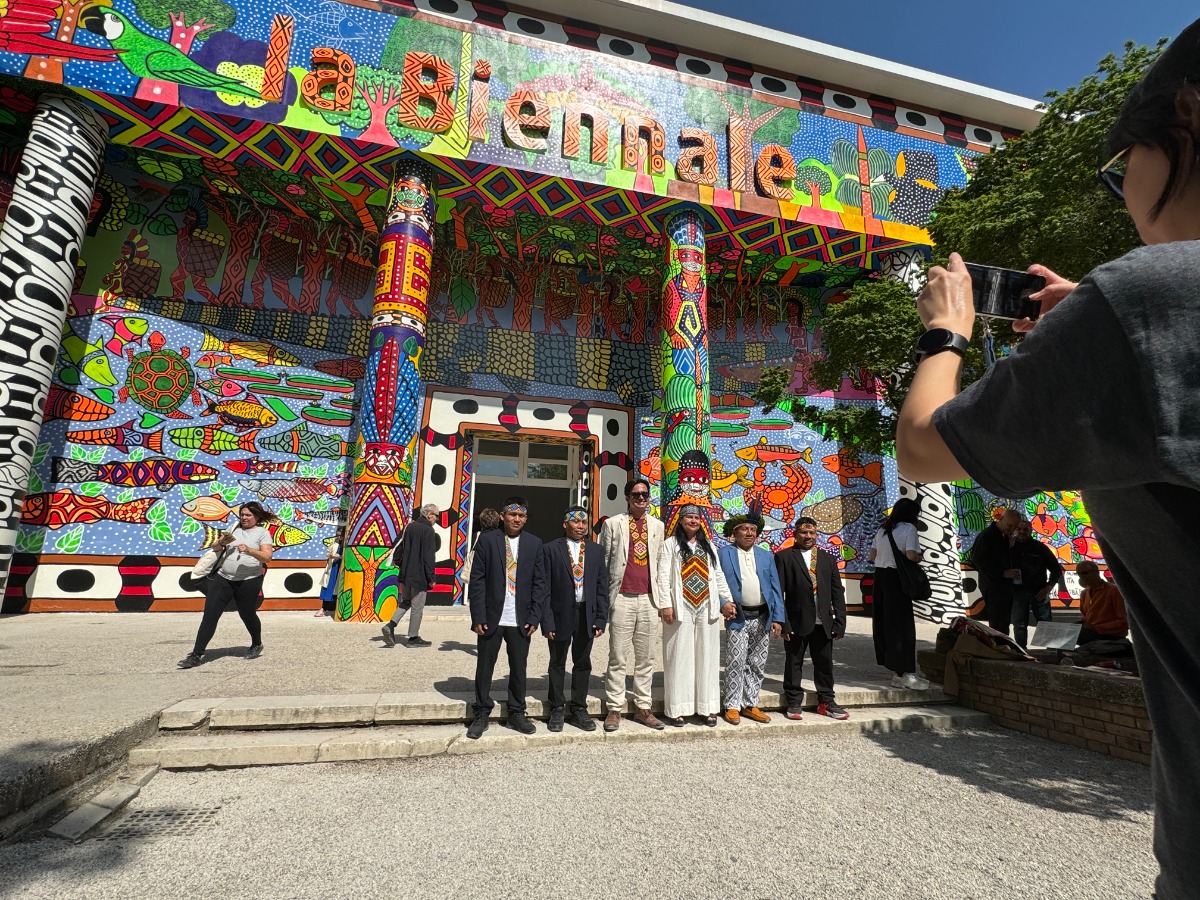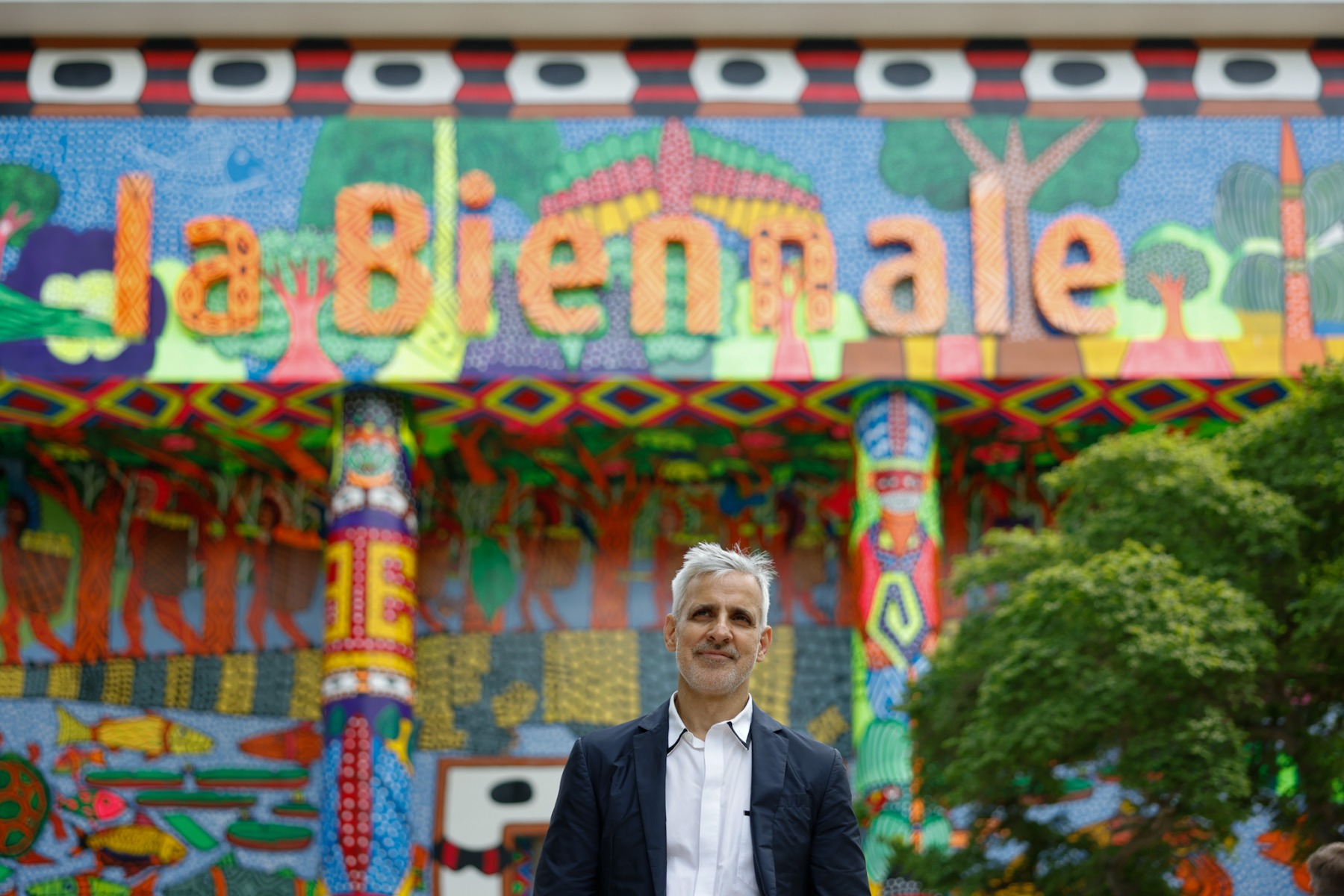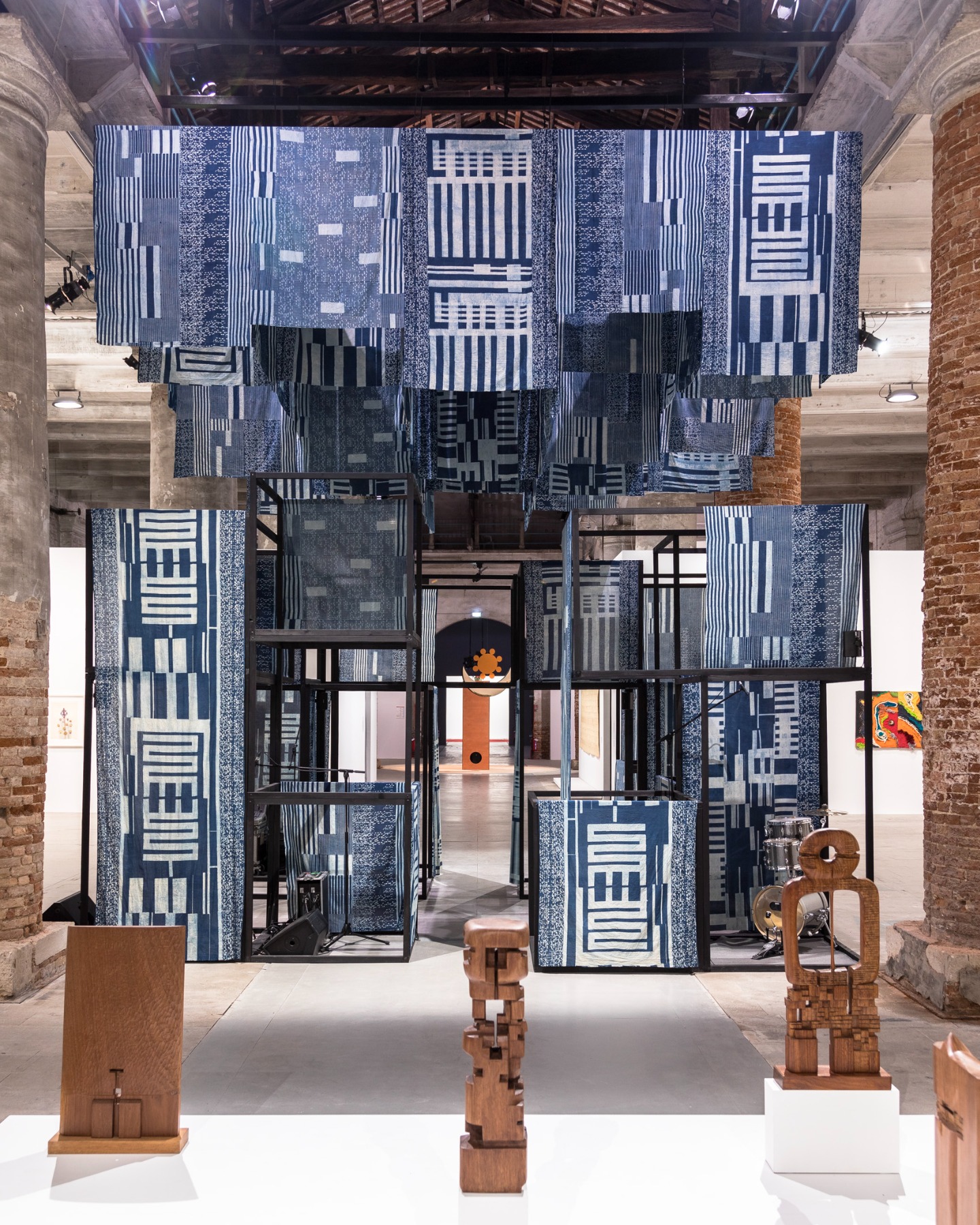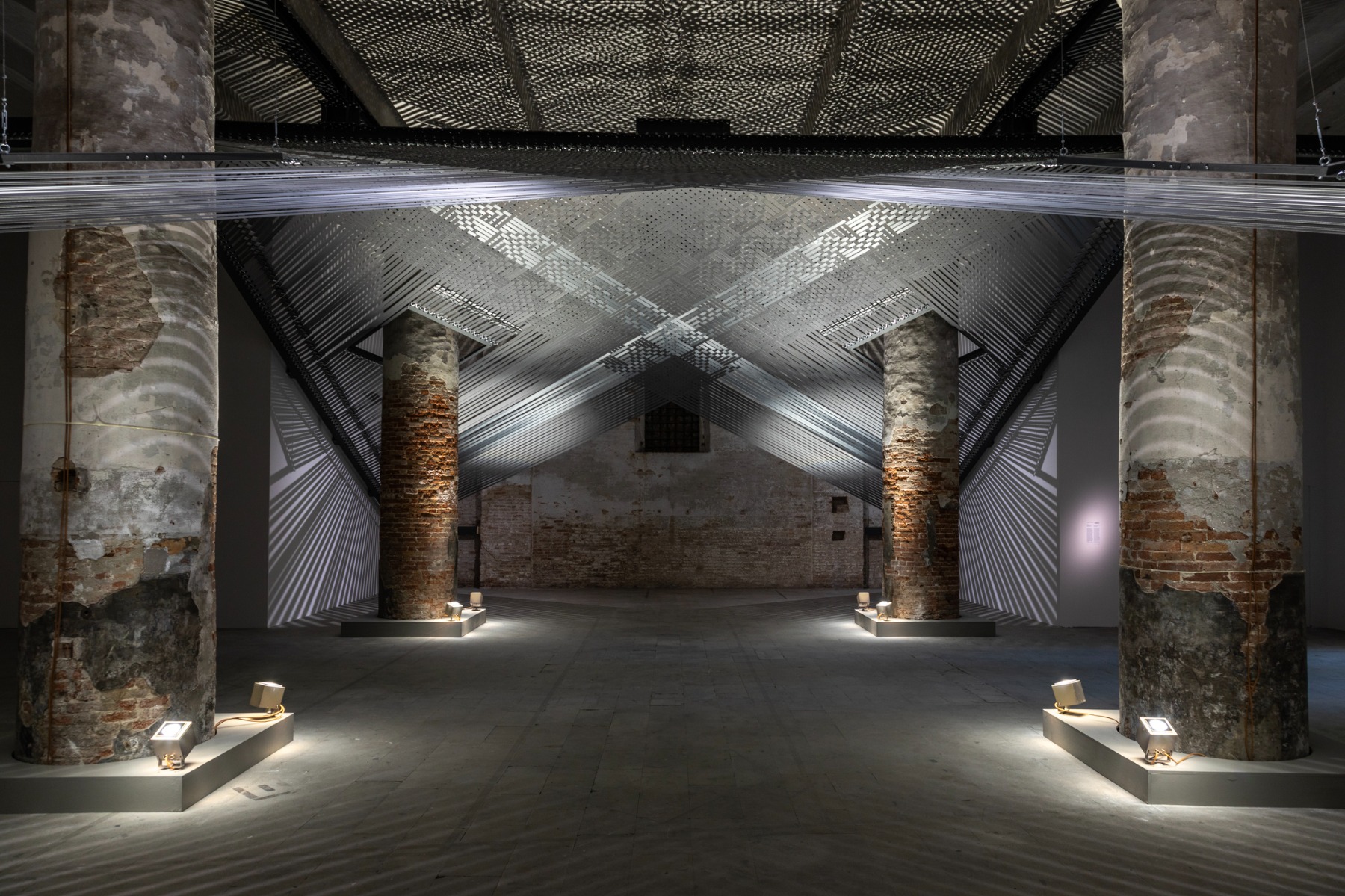
Is It about Art or the Maker?
On the 60th Venice Biennale
Visiting the Venice Biennale’s main exhibition Foreigners Everywhere means encountering many different conceptions of art making – or safer would be to just say “making.” A recurrent question while navigating the exhibition is “What am I looking at?”
I speak about ownership with a member of an aboriginal clan in Australia who is present at the Arsenale. “If you ask me for my jacket, I have to give it to you, because we are related,” he says. What is earned in his community, for instance through selling paintings, is shared; there is no hierarchy between people, or animals.
One of their painters, Naminapu Maymuru-White, was invited to present at the Biennale a series of bark paintings that show animal and celestial motifs, and are based on centuries-old stories. The practice requires the maker to follow patterns of depiction as they have been passed down. They are meant to invoke old wisdom, and to connect the earthly sphere with heaven, the ancestors with the present. “When I go back, I don’t have a room with nice art works, I look into the eyes of a crocodile,” the man tells me, picturing the ferocity of nature back home, far from the city. “Do you eat animals?” I ask him. “Sure, and they eat us.”
Naminapu Maymuru-White. Mayaŋura malaŋu miḻŋ’miḻŋ. (Stars reflected in the River), 2023
Multi-panel bark painting, appr. 300 × 1100 cm
60th International Art Exhibition – La Biennale di Venezia, Stranieri Ovunque – Foreigners Everywhere
Photo: Marco Zorzanello / Courtesy: La Biennale di Venezia
The textiles, paintings, videos, sculptures, and other artifacts presented at this year’s Biennale are made for particular reasons, though not necessarily as art. What supposedly connects all the makers in the exhibition is that they are in some way foreign, be it indigenous, refugee, queer, or otherwise outside the mainstream – that is, in the eyes of curator Adriano Pedrosa, who leads the São Paulo Museum of Art. He has chosen mostly makers who originally come from the global South, and given them full stage. Thereby he focuses on the one hand on the 20th century to show how modern art has developed in different regions in the South, producing slightly different variations on vocabularies such as abstraction in painting. On the other hand, the focus is on current practices in all their diversity.
Adriano Pedrosa. Photo: Jacopo Salvi
“I don’t know what I am looking at,” a gallery owner exclaimed, after having spent a day in the exhibition. Such a response could indicate excitement about meeting the unknown, but in this case it expressed frustration. The paradox with looking at something unknown is that it only resonates in the viewer if there is some level of familiarity about the discourse in which it could be discussed, be it about form or themes, about actions or concerns. It is the curator’s task to provide that frame-work, or direct the gaze through grouping and combining works. In Venice, though, a common base is not there; there is no aesthetic argument guiding the exhibition, which makes it very hard to compare things. Every work is a window to a world, even reflecting aspects that in the secular Western societies may be missed. But this requires the viewer to shift gears in every curve while going through the show: Is it craft, folk art, criticism, spiritual practice, political activism, or documentation? All of that can be found, and more.
Antonio Jose Guzman & Iva Jankovic
Orbital Mechanics, from the Electric Dub Station series, 2024
Ajrakh Hand Block Printed
Indigo Dyed Fabrics printed
Site Specific Installation
Variable Dimensions
60th International Art Exhibition – La Biennale di Venezia, Stranieri Ovunque – Foreigners Everywhere
Photo: Marco Zorzanello / Courtesy: La Biennale di Venezia
The curator has collected stories about people, about their mobility status as migrants. There is a room full of paintings made by Italians who had to leave the country. Many of the paintings would be dismissed by art museums, as they show something we have already seen. Pedrosa hangs them, though, with a story about the maker and the (involuntary) travels made, all notated on the back of the work, and visible through transparent framing. A floating hanging system allows the works to be seen from both sides.
Andrés Curruchich. Procesión: patrón de San Juan está en su trono, 1966
Oil on canvas, 43.5 × 48.3 cm
Collection of El Museo del Barrio, New York. Gift from Gale Simmons, Craig Duncan and Lynn Tarbox in memory of Barbara Duncan, 2007
Photo: Matteo de Mayda / Courtesy: La Biennale di Venezia
In one case of Indigenous painting, presented in the central pavilion, I did actually know what I was looking at: works by two painters from the Curruchich family. Traveling in Guatemala more than 30 years ago, I had been told about a school of painters in San Juan Comalapa, a village up in the mountains an hour by bus from Antigua. I went to see the heritage of Andres Curruchich, who had worked there in the 1930s, and whose special talents and supernatural abilities were discovered during renovations of the local church. I visited a collective named Surrealistas Kakchiquel, formed by five women who made clothing and paintings. In remote villages like San Juan Comalapa, many descendants of the Mayans were killed during the civil war in the 1970s and ‘80s. The violent history has informed the work they make, in hidden ways. One maker pointed to the mountain slopes in her painting, where faces emerge from the vegetation. “Espanto,” she said with a meaningful look, and repeated the word a few times, indicating fear or terror. I was impressed with her story, and the colorful clothes that were produced seemed strong markers of their culture. But I could not help but think that the paintings they made would, in Europe, probably end up in an ethnographic museum, rather than an art museum. It turned out I was wrong. Or at least, in 2024, these works made their way into a Biennale that wants to shift the attention to a broader range of artistic production.
Mataaho Collective. Takapau, 2022
Installation (polyester hi-vis tiedowns, stainless steel buckles and j-hooks)
Site specific reconfiguration Museum of New Zealand, Te Papa Tongarewa
60th International Art Exhibition – La Biennale di Venezia, Stranieri Ovunque – Foreigners Everywhere
Photo: Marco Zorzanello / Courtesy: La Biennale di Venezia
Usually the stories we tell around art give background and context to the visuals. They are the stories behind the artwork. In the 60th Biennale, this order seems to be inverted. First there is the story about the maker, and only afterwards do you find the work they made. We are looking at identity issues, migration stories, a disobedience archive, tales of coming-out and (non-)acceptance, cosmologies from far away. And all this is glued together by the fact that it is made by a certain type of maker (the foreigner, the outsider, the overseen, the displaced). Yet, such identities do not make a show. There is no coherence provided through the works, their content, their possible correspondences, their intrinsic qualities, their aesthetic emanation. It seems that the curator has left the viewer alone instead of making combinations of the works that could bring out certain meaning.
MAHKU (Movimento dos Artistas Huni Kuin). Kapewe Pukeni [Bridgealligator], 2024
Site-specific installationm 750 m2
60th International Art Exhibition – La Biennale di Venezia, Stranieri Ovunque – Foreigners Everywhere
Photo: Matteo de Mayda / Courtesy: La Biennale di Venezia
Foreigners Everywhere is a bold Biennale. It provides a stage for makers from the global South, and for those who are identified as foreigners of some kind, yet it does so without caring much about an aesthetic program or an orchestration that relates these works to a Western audience. It seems to be the result of years of survey, delving up multiple options from the global South and putting them on the map, a reservoir from which to draw an exhibition parcours.
Aloïse.Luxembourg bal Sylvestre, 1951-60
Coloured pencils on five sheetsof paper sewn together, 156 × 91 cm
60th International Art Exhibition – La Biennale di Venezia, Stranieri Ovunque – Foreigners Everywhere
Photo: Matteo de Mayda/ Courtesy: La Biennale di Venezia
As a writer, I like stories, and during the Biennale’s opening, I enjoyed conversations with makers from diverse backgrounds. Yet, from the Venice Biennale, I expect more than stories. Traditionally, it is a place to measure the artistic temperature of the last few years, where you get a feeling of what and who is important in the arts, or where we are going. In this case, there is no such feeling. What Pedrosa presents are many possibilities, yet without delivering the urgency or understanding to accept his choices. To get a sense of where we are, in turbulent times, the offer in the national pavilions is more rewarding (a separate report on this will follow).
Additionally, there are other exhibitions in town which open up the perspective also to Western art. There is a journey into the Heart of Darkness by Viennese painter Martha Jungwirth, a hilarious portrait of capitalism by Christoph Büchel at the Prada Foundation, and an impressive exhibition by Pierre Huyghe, Liminal. Huyghe makes art, often in moving images, that goes from the material and physical to the metaphysical, and in that capacity, it has the power to touch people of many walks of life and origin. At the same time, his work shifts between a human and non-human perspective; it is cold and empathic at the same time. The work touches on the fact that everybody is, at times, a foreigner in life. Or even stronger, it makes us aware of the fact that we cannot really speak of our body or our life. We are all just passengers.
Aravani Art Project. Diaspore, 2024
Mural painting, 2715 × 600 cm
60th International Art Exhibition – La Biennale di Venezia, Stranieri Ovunque – Foreigners Everywhere
Photo: Andrea Avezzù / Courtesy: La Biennale di Venezia

Title image: MAHKU (Movimento dos Artistas Huni Kuin). Kapewe Pukeni [Bridgealligator], 2024. Site-specific installationm 750 m2. 60th International Art Exhibition – La Biennale di Venezia, Stranieri Ovunque – Foreigners Everywhere. Photo: Una Meistere